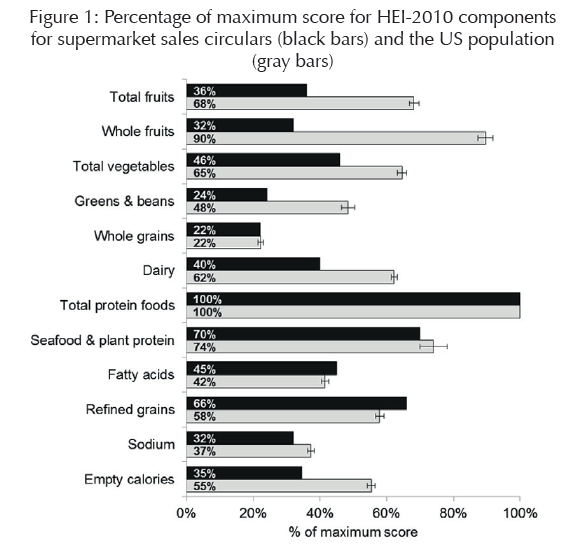Diet quality of items advertised in supermarket sales circulars compared to the diets of the US population, as assessed by the Healthy Eating Index-2010
Supermarket sales circulars
Worldwide, supermarkets use sales circulars to highlight specific foods that maximize store profitability, usually at discounted prices. Circulars therefore function to promote sales of items that help form the set of available foods within households from which families and individuals make choices about what to eat. If circulars promote discretionary foods (usually high in added sugars and solid fats), they have the potential to adversely affect diet quality and contribute to the obesity epidemic.
In most countries, supermarket sales circulars promote unhealthy foods, with discount stores advertising more unhealthy foods than traditional supermarkets1-3. In the US, content analyses have shown that items advertised in sales circulars are not concordant with federal dietary guidance. However, the quality of the total mix of foods had not been evaluated. The aim of this study was to quantify the diet quality of the items promoted in one year’s worth of weekly supermarket flyers using the US Healthy Eating Index-2010 (HEI-2010) diet scoring system6. We also compared the HEI-2010 scores of the diet of the US population to those of the sales circulars to assess their comparability.
Study design
This study involved analysis of 52 weekly Sunday supermarket sales circulars from one chain store in a small Midwestern town in the USA and the nationally representative National Health and Nutrition Examination Survey (NHANES). The HEI-2010 scoring system is composed of 12 food group and nutrient components which are then added to derive a total score. Nine components are recommended for Americans to consume more of and three are components that should be consumed in moderation. The NHANES data consisted of 24-hr recall data reported by 9,522 individuals aged two years and older. Each food item from the circulars was coded (excluding nonfood items and alcohol), resulting in 9,149 items coded using the same schema as the NHANES. The codes were used to construct the components of the HEI-2010 for both datasets.
HEI-2010 scores of the sales circulars and US population The total HEI-2010 score for the circulars was 42.8 out of a maximum of 100 points, lower than the total population score of 55.4 ± 0.7. Scores were lower for several dietary components, including empty (discretionary) calories (Figure 1). Our results indicate that sales circulars may be nudging consumers in the direction of unbalanced diets by promoting items that are low in vegetables, fruits and dairy and higher in salt and discretionary calories. Modifying sales circulars to more closely reflect dietary guidance is a potential way for public health interventions to promote a healthier dietary intake, especially for budget-conscious shoppers.
Figure 1: Percentage of maximum score for HEI-2010 components for supermarket sales circulars (black bars) and the US population (gray bars)

References
- Ravensbergen EA, Waterlander WE, Kroeze W, Steenhuis IH. Healthy or Unhealthy on Sale? A cross-sectional study on the proportion of healthy and unhealthy foods promoted through flyer advertising by supermarkets in the Netherlands. BMC Public Health. 2015;15:470.
- Charlton EL, Kahkonen LA, Sacks G, Cameron AJ. Supermarkets and unhealthy food marketing: An international comparison of the content of supermarket catalogues/circulars. Prev Med. Dec 2015;81:168-173.
- Cameron AJ, Sayers SJ, Sacks G, Thornton LE. Do the foods advertised in Australian supermarket catalogues reflect national dietary guidelines? Health promotion international. Sep 16 2015.
- Martin-Biggers J, Yorkin M, Aljallad C, et al. What foods are US supermarkets promoting? A content analysis of supermarket sales circulars. Appetite. Mar 2013;62:160-165.
- Jahns L, Payne CR, Whigham LD, et al. Foods advertised in US weekly supermarket sales circulars over one year: a content analysis. Nutr J. 2014;13(1):95.
- Jahns L, Scheett AJ, Johnson LK, et al. Diet Quality of Items Advertised in Supermarket Sales Circulars Compared to Diets of the US Population, as Assessed by the Healthy Eating Index-2010. J Acad Nutr Diet. Jan 2016;116(1):115-122.e111.
